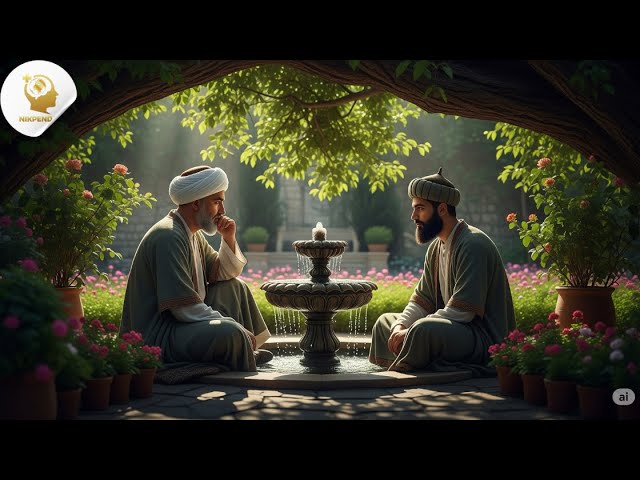
Beginner
Task 1: Describe the People
After watching the video, work with a partner to describe the two main people: Rumi and Shams of Tabriz. Use simple sentences.
- Rumi: What was he like at the beginning? What did he become?
- Shams of Tabriz: What did he look like? What did he do?
Task 2: Discuss a Metaphor
The video uses the metaphor of a candle to describe a person. Discuss with a partner what this means.
- What does the candle represent?
- What does the flame represent?
- What does it mean when the candle becomes “entirely flame”?
Task 3: Share Your Opinion
Tell your partner or a small group your favorite part of the video. Use simple sentences to explain why.
- Do you like Rumi’s poetry?
- Do you like the story of the books catching fire?
- Do you like the story of Leila and Majnun?
Intermediate
Task 1: Role-Play a Conversation
With a partner, role-play a conversation between Rumi and one of his former followers. The follower is upset that Rumi is no longer a traditional scholar. Rumi must explain his new beliefs and his relationship with Shams.
- Follower: “Why have you stopped studying Islamic law?”
- Rumi: “I am now focused on divine love.”
- Follower: “What about the strange dancing and poetry?”
- Rumi: “These are ways to express my love for God.”
Task 2: Present a Summary
In a small group, each person should summarize one key event from Rumi’s life as presented in the video. Then, present your summaries in the correct order to the rest of the group.
- The meeting with Shams and the burning books.
- The disappearance of Shams and Rumi’s reaction.
- The writing of Diwan and Masnavi.
Task 3: Discuss the Concept of Love
The video discusses different kinds of love. With a partner, discuss the following questions:
- How does the video describe divine love?
- How does Rumi’s story of Leila and Majnun explain the difference between romantic love and divine love?
- Do you agree with Rumi’s idea that “love resides not in learning, not in knowledge, not in pages and books”? Why or why not?
Advanced
Task 1: Philosophical Discussion
In a group, discuss the deeper philosophical ideas presented in the video.
- Analyze the metaphor of Rumi as the “moon” and Shams as the “sun.” What does this tell you about Rumi’s self-perception and how it changed over time?
- Discuss the video’s statement that Rumi’s message is “universal” despite his specific historical and religious context. Do you agree? What aspects of his message are universal?
- Debate the relationship between academic knowledge and mystical experience, using Rumi’s transformation as a case study.
Task 2: Deliver a “Mini-Lecture”
Choose one of the following topics from the video and prepare a short, informative talk (2-3 minutes) to present to the class. Use your own words to explain the concept.
- The historical and cultural context of Rumi’s work.
- The tension between traditional Islamic observance and Sufism.
- The evolution of Rumi’s poetry from the Diwan to the Masnavi.
Task 3: Interpret a Quote
Choose one of the quotes from the video and explain its meaning to a partner or small group. Do not simply define the words; provide a deeper interpretation of the quote’s significance within the context of the video.
- “A candle is made to become entirely flame.”
- “I am Leila. The problem is you are not Majnun.”
Beginner
Task 1: Listen and Identify
Listen to the video and identify the name of the two main people. You can write their names or point to them if a visual is provided.
Task 2: Answer Simple Questions
Listen to the video and answer the following questions with a short phrase or a single word.
- What did Rumi’s books do when Shams appeared?
- What did Rumi become after meeting Shams?
- What is one thing that Rumi wrote?
Task 3: Find the Missing Word
Listen to the video and fill in the blank with the correct word.
- A candle is made to become entirely __________________.
- The mysterious figure was Shams of __________________.
- Rumi expressed his devastation through __________________.
Intermediate
Task 1: Listen for Key Information
Listen to the video and take notes on the following topics. Afterward, use your notes to answer the questions.
- Rumi’s early life: Where was he born? What was his job before meeting Shams?
- Shams of Tabriz: What was his profession? What was his purpose in meeting Rumi?
- The Masnavi: What is the main idea of this work? What does it aim to teach others?
Task 2: Listen for Chronological Order
Listen to the video and number the events in the order that they happened.
- Rumi wrote the Masnavi.
- The Mevlevi Sufi order was established.
- Shams of Tabriz disappeared.
- Rumi met Shams in a lecture hall.
Task 3: Listen for Main Ideas
Listen to the video and summarize the main idea of each of the three key sections:
- The initial meeting: How did Shams change Rumi’s path?
- The disappearance of Shams: How did this event affect Rumi’s work?
- The mature philosophy: How did Rumi’s poetry evolve, and what was its new purpose?
Advanced
Task 1: Listen for Implicit Meaning
Listen to the video and explain the deeper meaning behind these statements, based on the context.
- “In that annihilating moment, it has no shadow.”
- Rumi saw himself as the “moon, reflecting the light of Shams’s sun.”
- “I am Leila. The problem is you are not Majnun.”
Task 2: Listen and Critique
Listen to the video with a critical ear. Identify the key arguments or claims made and discuss them in a small group.
- Does the video provide enough evidence to support the claim that Rumi’s poetry “matured”?
- How does the video present the conflict between Rumi’s new beliefs and the “conservative religious elites”? Is this a balanced portrayal?
- Analyze the claim that Rumi’s message is “universal.” What aspects of the video support this?
Task 3: Detailed Note-Taking and Analysis
Listen to the video and take detailed notes on the different literary and philosophical concepts mentioned. Then, write a brief analysis of how these concepts are interconnected.
- Concepts to analyze:
- The transition from academic law to divine love.
- The roles of Shams and Rumi in their spiritual partnership.
- The symbolism of the candle, the moon, and the sun.
- The relationship between romantic love and divine love
Beginner
Task 1: Matching
Read the sentences about Rumi and match the first part of the sentence to the correct second part.
- Rumi was a famous
- He met a man named
- The books
- Rumi wrote many
- Rumi’s message is seen as
Sentences: a. caught fire. b. Shams of Tabriz. c. universal. d. poet and philosopher. e. poems.
Task 2: True or False
Read the following sentences. Write “T” if the sentence is true or “F” if it is false, based on the video.
- Rumi was an academic scholar before he met Shams.
- Shams was a king.
- After Shams disappeared, Rumi stopped writing poetry.
- Rumi’s poems were introduced to the West in the 19th century.
- The Mevlevi Sufi order exists today.
Task 3: Vocabulary and Definitions
Read the following words from the video and match them to their simple definitions.
- renowned:
- disheveled:
- mystic:
- devastation:
- universal:
Definitions: a. known and respected by many people. b. something that is true for everyone and everything. c. a person who tries to experience a spiritual connection with God. d. very untidy; a messy appearance. e. a feeling of great sadness or destruction.
Intermediate
Task 1: Read for Specific Details
Read the video and answer the following questions with details from the text.
- What was Rumi’s profession when he first met Shams?
- What did Rumi’s earlier followers do when he embraced Sufism?
- Why did Rumi begin to see himself as a “beacon of light on his own”?
- What does the story of Leila and Majnun teach about love?
- In what century was Rumi’s work introduced to the West?
Task 2: Find the Quotes
Read the video carefully and find the quotes that match the descriptions below.
- The quote that Shams says after the books catch fire.
- The quote that explains Rumi’s new view on books and knowledge.
- The quote that Rumi wrote to express his sadness after Shams’s disappearance.
- The quote from Leila to the king.
Task 3: Summarize a Paragraph
Choose one of the following key ideas from the video and write a short paragraph (3-4 sentences) summarizing it in your own words.
- The initial meeting between Rumi and Shams of Tabriz.
- The effects of Shams’s disappearance on Rumi’s life and work.
- The difference between the Divan and the Masnavi.
Advanced
Task 1: Analyze Text Structure
Read the video and analyze its structure. Answer the following questions.
- How does the video’s opening metaphor of the candle introduce the central theme of transformation?
- How does the video use a chronological structure to trace Rumi’s spiritual and literary evolution?
- What is the purpose of the final paragraph? How does it connect Rumi’s specific historical context to a broader, universal message for the audience?
Task 2: Critical Reading and Interpretation
Read the video and write a short response to the questions below. Support your answers with specific evidence from the text.
- The video states that Rumi’s poems are “complex and layered.” How does the text prove this claim? What specific examples are provided?
- What does the video imply about the nature of Sufism and its relationship with mainstream Islamic observance? What are the sources of conflict?
- The video describes Rumi’s work as being “read and reread, translated and reinterpreted.” What does this suggest about the enduring nature of his message?
Task 3: Vocabulary in Context
Read the video and explain the meaning of the following words as they are used in the text.
- annihilating (Paragraph 1)
- charismatic (Paragraph 1)
- looms large (Paragraph 1)
- ecstatic (Paragraph 2)
- invincible (Paragraph 4)
- adept (Paragraph 4)
Beginner
Task 1: Fill in the Blanks
Read the following sentences about Rumi’s life and fill in the blanks using words from the video.
- Rumi was a famous __________________ and mystic philosopher.
- He was born in __________________ near the city of Balk.
- Rumi’s books caught __________________ when a mysterious man appeared.
- This man was __________________ of Tabriz.
- Rumi’s new poems were about divine __________________.
Task 2: Write a Short Description
Write a short paragraph (2-3 sentences) about either Rumi or Shams of Tabriz. Use simple words to describe who they were and what they did.
Task 3: Draw and Label
Draw a picture of an object or person mentioned in the video (e.g., a candle, a book, Rumi, Shams). Write a simple sentence to label your drawing, such as “This is a candle.” or “This is Shams of Tabriz.”
Intermediate
Task 1: Summarize an Event
Write a short paragraph (4-5 sentences) summarizing the story of Rumi and Shams of Tabriz. Explain how their first meeting and the subsequent disappearance of Shams changed Rumi’s life and work.
Task 2: Write a Journal Entry
Imagine you are a follower of Rumi. Write a journal entry describing the events after Shams’s sudden disappearance. Explain how you feel about the situation and how Rumi is reacting to his loss.
Task 3: Respond to a Quote
Choose one of the quotes from the video and write a short reflection (3-4 sentences) on what it means to you. Explain how the quote relates to your own experiences or beliefs.
- “Love resides not in learning, not in knowledge, not in pages and books.”
- “I am Leila. The problem is you are not Majnun.”
- “If you have lost heart in the path of love, flee to me without delay. I am a fortress invincible.”
Advanced
Task 1: Write an Essay
Write an essay (3-4 paragraphs) analyzing how Rumi’s work and philosophy matured over time. Discuss the differences between his early poetry, which expressed his longing for Shams, and his later works, like the Masnavi, which aimed to guide others. Use specific details from the video to support your points.
Task 2: Write a Philosophical Reflection
Reflect on the story of Leila and Majnun as presented in the video. Write a paragraph explaining the deeper meaning of this story and how Rumi used it to illustrate his concept of divine love. What is the difference between simply seeing beauty and experiencing it like Majnun?
Task 3: Create a Poem
Write your own poem (at least two stanzas) inspired by the themes in the video, such as divine love, loss, personal transformation, or finding light in darkness. Use vivid imagery and metaphorical language, similar to Rumi’s style.





